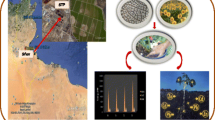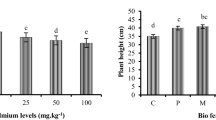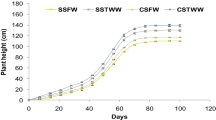Abstract
The objective of the present study was to investigate the potential of some plants to uptake and accumulate some essential elements and cadmium in soils under wastewater irrigation. The study was performed in the farmer’s field in 2005 at Varamin region located in the south of Tehran, Iran. The soil at the studied site belongs to Shahr-e-Ray Series and soil taxa “Fluventic Camborthids”. The sunflower, turnip and forage corn were selected for the investigation. The wastewater was used for irrigation purpose. The experiment was laid out in a randomized block design (RBD), and treatments were triplicated. The sunflower, turnip and forage corn plants were harvested in 2005, and the plants were separated into roots and aboveground material. The results showed the highest concentration of nitrogen, phosphorus, zinc, copper and cadmium was 6.05%, 1.27%, and 97.27, 22.84 and 0.54 mg kg−1 in sunflower, respectively, and the most accumulations of nitrogen, phosphorus, zinc and copper were in grain and cadmium in the leaf. The concentration of potassium and nitrate was 5.79 and 8.26% in turnip, respectively, and the high accumulation of potassium and nitrate was in leaf. The highest concentration of iron and manganese was 349.56 and 144.78 mg kg−1, respectively, in forage corn. The results suggest that the lands irrigated with wastewater with excessive amount of essential elements and cadmium can support sunflower cultivation through uptake of sufficient quantities by selected crops.
Access provided by Autonomous University of Puebla. Download chapter PDF
Similar content being viewed by others
Keywords
1 Introduction
The nutrient availability changes continuously due to the application of macro- and micronutrients and other trace elements through the application of fertilizers, biosolids, irrigation with wastewater or indirect sources (car exhausts, rainfall and atmospheric deposition from several sources, etc.). Soils, as filters of toxic chemicals, may adsorb and retain heavy metals from wastewater. However, when the capacity of soils to retain toxic metals is reduced due to continuous loading of pollutants or changes in pH, soils can release heavy metals into groundwater or soil solution available for plant uptake. The effects of wastewater irrigation on the availability of some micronutrients and heavy metals in calcareous soil in the south of Mosul, Iraq, showed that the concentration of Fe, Zn, Mn and Cu as micronutrients and Pb, Ni and Cd as heavy metal increased (Meani et al. 1993). Microbial decomposition of organics in wastewater can also release heavy metals into soil solution. But, because of their low solubility and limited uptake by plants, heavy metals tend to accumulate in surface soil and become part of the soil matrix (McGrath et al. 1994). With repeated wastewater applications, heavy metals can accumulate in soil to toxic concentrations for plant growth. The long-term effects of irrigation with wastewater in the south of Tehran, Iran, showed that the available concentration of organic carbon (OC), P, K, Zn, Cu, Cd, Pb and Ni was more than those in control soils (Molahoseini 2001) without significant decrease of wheat and forage corn yield. This practice can lead to reduce the amount of nitrogen, phosphorus and potassium required for crops to less than 75% of the recommended doze determined through soil tests in the laboratory (Molahoseini 2003, 2005).
The results of heavy metal contents of crops in the south of Tehran, Iran, showed that the maximum accumulative concentration of these metals occurs in the order of leaf > tuber > root > stem > fruit > seed. The greatest uptake was found in turnip, lettuce, radish (leaf), sugar beet (leaf) and spinach, while the least was in rice and wheat (grain) and beetroot (Shariati et al. 1998). Phytoremediation is one of the environmental friendly technologies that use plants to clean up soil from heavy metal and trace element contamination.
The uptake and accumulation of pollutants vary from plant to plant and also from species to species within a genus (Singh et al. 2003). Another agronomic principle, which has been neglected in phytoremediation research, is crop rotation. Because of the proliferation of weeds, predators and diseases, which can cause significant yield reduction, crops, including those used for soil remediation, must be rotated. In general, crops are rotated less frequently today than 30 years ago. From crop science, it can be extrapolated that short-term (2–3 years) monoculture (the use of the same species in consecutive seasons) may be acceptable for metal phytoremediation.
However, for longer-term applications, as most metal phytoextraction projects are anticipated, it is unlikely that successful metal clean up can be achieved with only one remediative species used exclusively in monoculture. Plant rotation is even more important when multiple crops per year are projected (Lasat et al. 2000). In general terms, the macronutrient and micronutrient concentrations for the three crops were lower than that showed by Plank et al. (1995). The normal range of nitrogen (N), phosphorus (P), potassium (K), Iron (Fe), Manganese (Mn), Zinc (Zn) and copper (Cu) was reported in the range of 3–5, 0.3–0.5 and 3–5% and 100–200, 50–100, 50–70 and 10–20 ppm in sunflower; 3–5.5, 0.35–0.8 and 3–5% and 80–370, 30–100, 20–70 and 3–10 ppm in turnip; and 3–3.5, 0.25–.045 and 2–2.5% and 30–200, 15–300, 15–60 and 3–15 ppm in forage corn, respectively (Plank et al.1995). The normal range of cadmium (Cd) was 0.2–0.8 ppm in all of the plants (Ross 1996), and normal range of nitrate (NO3) ion was less than 0.45% (Maynard 1978).
The long-term effects of soils under wastewater irrigation in the south of Tehran, Iran, cause to increase the available concentration of OC, P, K, Zn, Cu, Cd, Pb and Ni more than control soils. This study was carried out to evaluate plant potential of sunflower, turnip and forage corn to uptake and accumulate some essential elements and cadmium in soils under wastewater irrigation located south of Tehran.
2 Materials and Methods
2.1 Study Site
The average annual rainfall in the study area is about 173 mm; therefore, it is situated in the arid zone (Table 49.1). Field experiment was conducted by irrigating the plots with wastewater. The experiment was conducted in the south of Tehran, Iran (Fig. 49.1). The general view of experiment is shown in Fig. 49.2. The soil at the study site belongs to Shahr-e-Ray Series (total area of Shahr-e-Ray Series is 3,290 ha). The soil profile displayed a cambic horizon in the upper 1 m from soil surface and has been located in River Alluvial Plain (Table 49.2). The soil taxa at soil family level based on USDA soil taxonomy is “Fine Mixed, Thermic, Fluventic Camborthids” (Iravani, 2000). The basic soil characteristics (0–30 cm) are given in Table 49.3. The studied site is slightly alkaline in reaction and silty clay loam in texture.
It is worth emphasizing that the selected site was previously used for wheat cultivation, where wheat was harvested in July. The site was properly prepared for the experiment. The sunflower, turnip and forage corn were planted to investigate the ability of the different parts of plants to accumulate some elements. The cultivars of sunflower, turnip and forage corn were Hyson33, Native and Single Cross 704, respectively. The wastewater irrigation scheduling was with the interval of 6 days, and 10 cm (4 in.) water was applied per irrigation. The fertilizer was applied based on soil testing. The experiment was conducted during 2005 and 2006, using randomized block design, with three replications in a net plot size of 30 m2.
2.2 Plant Sampling and Analysis
In the autumn of 2005, three plant samples per plot were collected. Each sample was a composite of two plants taken in the centre of the experimental plot. Each sample was separated into roots, aboveground materials (shoots, leaves, etc.) and grains, dried at 75°C in an oven, and then weighed, grounded, homogenized and a representative subsample analysed.
The samples were analysed for N using Kjeldahl apparatus; Olsen P was determined colorimetrically, and K was determined by using flame emission spectroscopy. The cadmium and trace elements (Cd, Cu, Fe, Mn and Zn) were extracted using DTPA (diethylenetriamine pentaacetic acid (DTPA)) and determined by atomic absorption spectrophotometer. In all cases, standard procedures described by Sparks et al. (1996) were used.
2.3 Statistical Analysis
All data were subjected to analysis of variance (ANOVA), and when significant differences (p < 0.05) were detected, Duncan’s test was performed to allow separation of means.
3 Results and Discussion
3.1 Mineral Composition of Plant Components
The analysis of variance of N, P, K, Fe, Mn, Zn, Cu and nitrate ion in grains shows highly significant effect (p < 0.01), whereas cadmium has shown significant effect (p < 0.05). The analysis of variance of N, P, K, Fe elements and nitrate ion in leaf and root of the plant treatments had high significant effect (p < 0.01). The analysis of variance of N, P, K, Zn, Cu and Mn elements and nitrate ion in the stem of the plants had high significant effect (p < 0.01). The mean mineral composition of roots and aerial biomass (leaf, stem and grain) of each crop are shown in Tables 49.4 (macronutrients) and 49.5 (micronutrients).
3.2 Macronutrient Concentrations of Crops
The concentrations of the studied macronutrients N, P, K and NO3 showed some differences according to the plant treatment and their components. The highest concentrations of N and P were in sunflower grain and K and NO3 in the turnip leaves (Table 49.4). According to Plank et al. (1995), the macronutrient concentrations of N, P and K for leaves of the three crops were lower than normal value, but nitrate concentrations in turnip leaves were more than normal range as stated by Maynard (1978) (normal range 0.45%).
3.3 Soil Macronutrient Uptake by Crops
The highest uptakes of N and P were 376.1 and 65.5 kg ha−1, respectively, by sunflower, and for K and nitrate ion were 294.2 and 347.3 kg ha−1, respectively, by turnip (Fig. 49.3).
3.4 The Crops Micronutrient and Cadmium Concentration
The concentrations and accumulation of the micronutrients and Cd also showed differences between the plant treatments (Table 49.5). The highest concentration of Fe and Mn was in forage corn root and leaves, respectively. The highest concentration of Zn and Cu was in sunflower grain and Cd was in sunflower leaves. According to Plank et al. (1995), the concentrations of Fe in forage corn and sunflower leaves were more than normal values whereas Mn in forage corn was less than normal values, and in sunflower and turnip leaves was close to the normal values. The Zn was lower than normal range in leaves of the three plants, but the concentration of Cu and Cd was more than normal range in turnip leaves.
3.5 Soil Micronutrient and Cadmium Uptake by Crops
The highest uptake of Fe, Cu, Zn and Cd was 2.955, 0.643, 0.2, 0.003 kg ha−1 by sunflower, respectively, and Mn was 0.537 kg ha−1 by forage corn (Fig. 49.4).
The results of this study showed that the plants of sunflower, turnip and forage corn have different potential to concentrate and accumulate essential elements and cadmium from lands under wastewater irrigation. Based on these results, the most concentration and accumulation of N, P, Zn and Cu were in sunflower grain and cadmium in sunflower leaf. The most concentration and accumulation of K and NO3 were in turnip leaf. Finally, the most concentration and accumulation of Fe was in forage corn root, and Mn was in forage corn leaf. It is therefore concluded that the proper plant rotation and suitable plant selection could decrease pollution of land under wastewater irrigation. Overall, the lands under wastewater irrigation with excessive amount of essential elements and cadmium could recommend sunflower to uptake excessive content of N, P, Zn, Cu and Cd; turnip to uptake excessive content of K and NO3; forage corn to uptake excessive amount of Fe and Mn without any yield decrease.
4 Conclusion
This study was carried out to evaluate the potential of sunflower, turnip and forage corn to uptake and accumulate some essential elements and cadmium in soils under wastewater irrigation in a site located south of Tehran. Based on the results of this experiment, lands under wastewater irrigation with excessive amount of essential elements and cadmium can support cultivation of sunflower to uptake excessive content of nitrogen, phosphorus, zinc, copper and cadmium; turnip to uptake excessive content of potassium and nitrate; and forage corn to uptake excessive content of iron and manganese without any yield decrease.
References
Iravani A (2000) The soil survey report of south of Tehran. Ministry of Agricultural Jeahad, Agricultural Research and Educational Organization, Soil and Water Research Institute, No. 616, Tehran
Lasat MM, Pence NS, Garvin DF, Ebbs SD, Kochian LV (2000) The use of plants for the removal of toxic metals from contaminated soil. American Association for the Advance of Environmental Science and Engineering Fellow, No CX 824823, Washington, DC
Maynard DN (1978) Potential nitrate levels in edible plant parts. In: Nielsen DR et al (eds) Nitrogen in the environment, vol 2, soil – plant nitrogen relationships. Academic, New York, pp 221–233
McGrath SP, Chang AC, Page AL, Witter E (1994) Land application of sewage sludge: scientific perspectives of heavy metal loading limits in Europe and the United States. Environ Rev 2:108–118
Meani AT, Juburi AL, Hamadany RH (1993) Effect of irrigation with wastewater on some micronutrients and heavy metals levels in calcareous soil Mij alat -Zira: 3at-al-ra: fidi: n (Iraq). Mesopotamia J Agric 25(4):27–35
Molahoseini H (2001) Investigation of intensive and beyond of soils pollution to heavy metal and plants under wastewater irrigation. In: Proceedings of the 7th Iranian soil science congress, Shahrekord University-College of Agriculture, Islamic Republic of Iran, 26–29 Aug 2001, pp 289–291
Molahoseini H (2003) Effect of N, P and K and plant population on quality and quantity characteristic of forage corn (704) under wastewater irrigation. In: Proceedings of the 8th Iranian Soil Science Congress, 26–29 Aug 2003, Rasht University-College of Agriculture, Islamic Republic of Iran, pp 289–291
Molahoseini H (2005) Effect of wastewater quality on supplying N, P and K for winter wheat cropping. In: Proceedings of the 9th Iranian Soil Science Congress, Karaj, Research Center of Watershed and Soil Conservation, Islamic Republic of Iran, 26–29 Aug 2005, pp 212–213
Plank CO, Granberry DM, Phatak S (1995) Plant analysis handbook for Georgia. Agricultural and Environmental Services Laboratories, Athens
Ross MS (1996) Toxic metals in soil-plant system. Wiley, Chichester
Shariati M, Farshi M, Nejad G (1998) Heavy metal contents of crops under wastewater irrigation in south Tehran. Proceedings of The 5th Iranian Soil Science Congress, pp 3–4
Singh OV, Labana S, Pandey G, Budhiraja R, Jain RK (2003) Phytoremediation: an overview of metallic ion decontamination from soil. Appl Microbiol Biotechnol 61:405–412
Sparks DL, Page AL, Helmke PA, Loeppert RA, Soltanpour PN, Tabatabai MA, Jhonston CT, Sumner ME (eds) (1996) Methods of soil analysis, part 3, chemical methods, 3rd edn. ASA, Madison, p 1390. ISBN ISBN-089118-072-9
Author information
Authors and Affiliations
Corresponding author
Editor information
Editors and Affiliations
Rights and permissions
Copyright information
© 2013 Springer Science+Business Media Dordrecht
About this chapter
Cite this chapter
Molahoseini, H., Feizi, M. (2013). The Performance of Sunflower, Turnip and Forage Corn in Uptaking Some Essential Elements and Cadmium Under Wastewater Irrigation. In: Shahid, S., Abdelfattah, M., Taha, F. (eds) Developments in Soil Salinity Assessment and Reclamation. Springer, Dordrecht. https://doi.org/10.1007/978-94-007-5684-7_49
Download citation
DOI: https://doi.org/10.1007/978-94-007-5684-7_49
Published:
Publisher Name: Springer, Dordrecht
Print ISBN: 978-94-007-5683-0
Online ISBN: 978-94-007-5684-7
eBook Packages: Earth and Environmental ScienceEarth and Environmental Science (R0)








